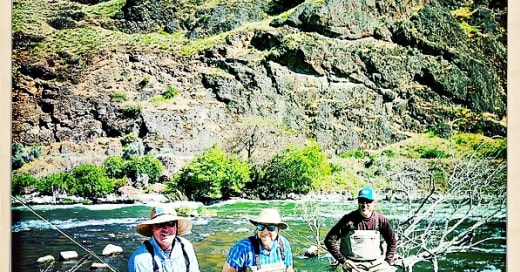I’m a day late this week because yesterday was my brother Andrew’s birthday, and my other brother, Ted, and I journeyed out to Oregon to spend the week with him, fly fishing at his cabin on the Deschutes River.
As I’ve written before, I’m a novice fly fisherman.
Taking up a new hobby in my mid-50s is not without its challenges, especially one that’s a physically demanding as wading waist-deep in a river that’s flowing at 4,000+ cubic feet per second. For example, the photo above was taken just after I’d fallen in the river and thrashed around a bit before someone helped me stand. Painful and humiliating and cold — and potentially dangerous, had it happened just a few feet away where the water was deeper.
Andrew’s cabin is on the far side of the river, accessible only by row boat, electrified by solar panels, WiFied by Elon’s Starlink. Behind us are bluffs that stretch for miles and tens of thousands of acres of native-owned land.
Andrew’s birthday happens to coincide with the hatch of the salmon fly, a massive insect — someone told me it’s a “bird in a bug suit.” After spending a couple years in the river as a nymph, the salmon flies climb onto shore in a sort of recreation of our own evolution, shuck their husks, and mate. Then they drop eggs in the river to reproduce, and they die. If they happen to drop onto the surface of the river during that glorious few weeks, they’re almost sure to be devoured by a trout.
Fishing during the salmon fly hatch is fun in part because you get to throw big flies, which are both easier to cast and easier to see than most other flies. And supposedly because the trout are less finicky than normal, gorging themselves on salmon flies, the most calorie-dense meals of the year.
But easier does not mean easy, at least not for a neophyte like me. Fly fishing is a practice, and I mean that in the Aristotelian sense:
Keep reading with a 7-day free trial
Subscribe to Tony’s Field Notes to keep reading this post and get 7 days of free access to the full post archives.




